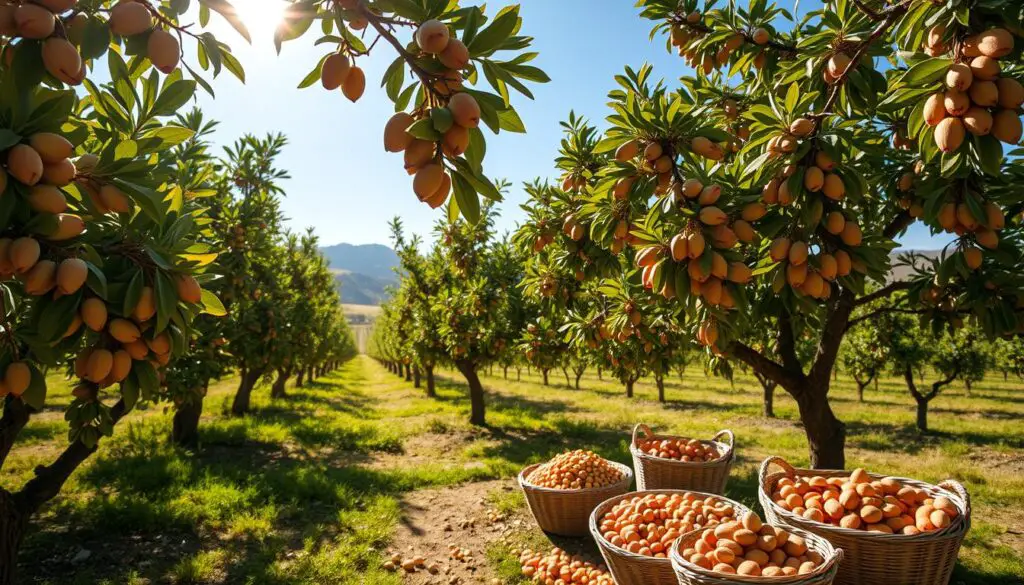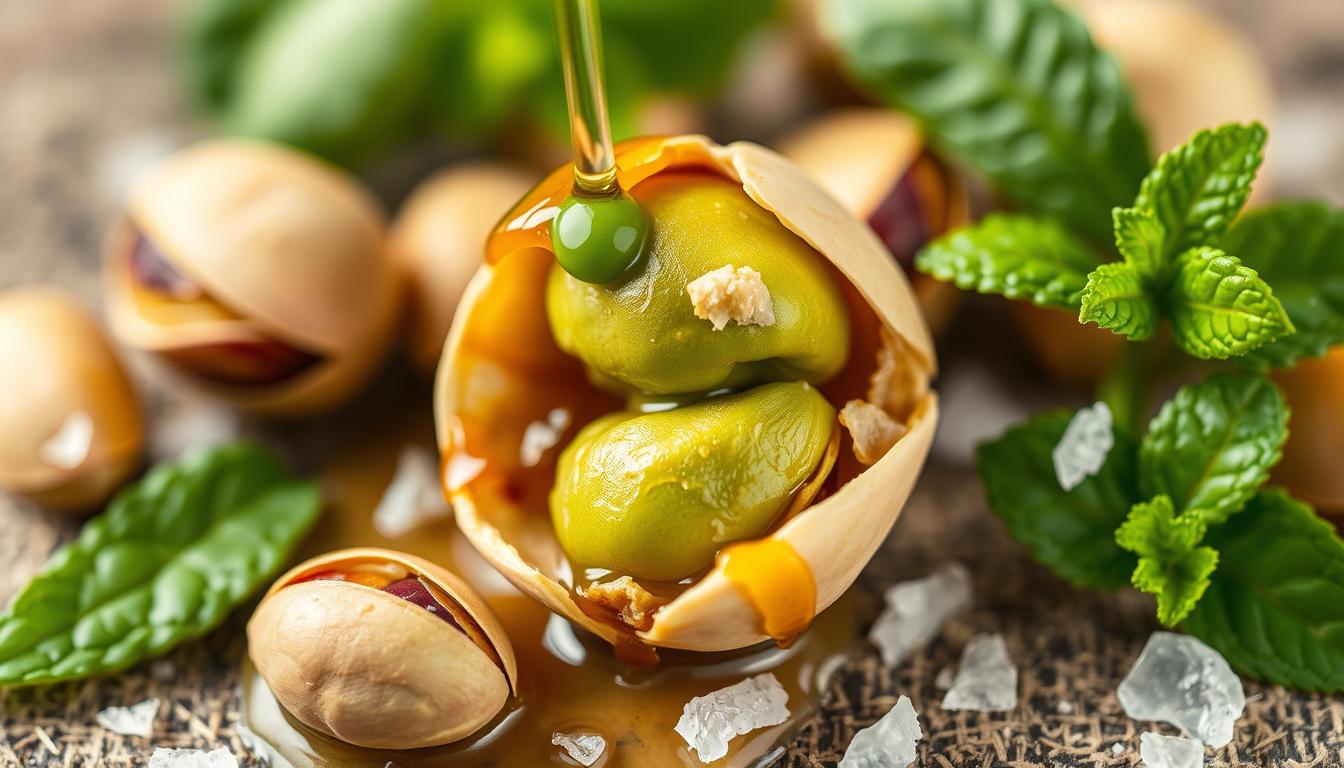Discover the secrets to unlocking the rich, distinctive flavour of pistachios. From cultivation to preparation, every step plays a crucial role in amplifying the natural taste of these beloved nuts. Whether you’re a seasoned chef or a home cook, understanding the factors that enhance pistachio flavour can elevate your culinary creations to new heights.
In this comprehensive guide, we’ll explore the multifaceted world of pistachio flavour, delving into the science behind it, the impact of growing conditions, and the transformative power of roasting and seasoning. Get ready to embark on a flavorful journey and unlock the true potential of this versatile ingredient.
Key Takeaways
- Understand the unique natural flavour profile of pistachios
- Discover how growing conditions and harvesting techniques impact taste
- Explore the art of roasting and seasoning to amplify pistachio flavour
- Learn how to pair pistachios with complementary ingredients for optimal taste
- Uncover the science behind flavour perception and its effect on the pistachio experience
Understanding the Unique Taste of Pistachios
Pistachios are beloved for their distinctive natural nut flavors, which have captivated taste buds around the world. Delving into the inherent characteristics of this cherished nut, we uncover the factors that contribute to its exceptional taste profile.
The Natural Flavor Profile
Pistachios are renowned for their delicate balance of sweet, salty, and savory notes. The natural oils within the nut provide a rich, creamy texture that melts on the tongue, while the subtle hints of nuttiness and buttery undertones linger pleasantly. This flavor profile is a testament to the nut’s inherent qualities, making pistachios a beloved snack and ingredient.
Factors Influencing Taste
- Pistachio Variety: Different cultivars of pistachios can exhibit varying taste characteristics, from the slightly sweeter Kerman variety to the more robust and savory Aegina type.
- Growing Conditions: The soil, climate, and cultivation practices where pistachios are grown can all impact the final flavor, with factors like terroir and microclimate playing a significant role.
- Roasting and Processing: The way pistachios are roasted, salted, or flavored can greatly influence their taste, with light roasts preserving more natural sweetness and dark roasts imparting deeper, nuttier notes.
Ultimately, the unique taste of pistachios is a result of the nut’s inherent properties as well as the various pistachio taste characteristics, natural nut flavors, and flavour influencing factors that shape its distinctive profile.
“The true beauty of pistachios lies in their ability to captivate the senses with their complex and ever-evolving flavor profile.”
Growing Conditions Impacting Flavor
The cultivation of pistachios is a delicate process, and the growing conditions play a crucial role in shaping the unique flavors of these beloved nuts. From the climate’s influence to the soil’s nutrient composition, every factor contributes to the ultimate taste experience.
Climate Considerations
Pistachios thrive in warm, dry climates with distinct seasons. The interplay of temperature, rainfall, and sunlight exposure during the growing season can significantly impact the flavor profile of pistachios. Regions with mild, Mediterranean-style climates, such as California and the Middle East, are particularly well-suited for pistachio cultivation, producing nuts with a rich, buttery taste and vibrant color.
Soil Type and Nutrients
The soil in which pistachios are grown plays a vital role in determining the flavor. Pistachios prefer well-drained, sandy loam soils that are rich in essential nutrients like phosphorus and potassium. The availability of these soil nutrients can influence the size, texture, and overall flavor of the nuts. Growers carefully monitor and manage the soil’s composition to ensure optimal growing conditions for their pistachio orchards.
“The perfect balance of climate and soil is the key to unlocking the exceptional flavors of pistachios.”
- Warm, dry climates with distinct seasons are ideal for pistachio cultivation.
- Well-drained, nutrient-rich soil is crucial for producing flavorful pistachios.
- Growers carefully monitor and manage the growing conditions to ensure the best possible taste experience.
Harvesting Techniques for Better Taste
Achieving the perfect pistachio flavor is not just about the growing conditions; it also relies on the meticulous handling of the nuts during harvest. From the optimal timing of the harvest to the post-harvest practices, every step plays a crucial role in preserving the unique taste and quality of these beloved nuts.
Timing of Harvest
The timing of the pistachio harvest is critical in ensuring the best flavor profile. Pistachios are typically harvested in late summer or early fall, when the nuts have reached their peak maturity and the shells have naturally split open. Recipe Classic experts emphasize that harvesting at the right time is essential to capture the distinctive balance of sweetness, nuttiness, and subtle bitterness that makes pistachios so sought-after.
Handling Practices
Once the pistachios are harvested, the way they are handled can significantly impact their final flavor. Careful post-harvest practices, such as proper drying, sorting, and storage, help preserve the natural oils and subtle nuances that contribute to the pistachio’s signature taste. Improper handling can lead to oxidation, loss of flavor, and even the development of off-flavors, so attention to detail is crucial throughout the entire process.
| Pistachio Harvesting Methods | Optimal Harvest Timing | Post-Harvest Handling Practices |
|---|---|---|
|
|
|
By understanding the importance of pistachio harvesting methods, optimal harvest timing, and post-harvest handling, food enthusiasts can ensure that the pistachios they use in their recipes or enjoy as a snack deliver the maximum flavor experience.
“Harvesting pistachios at the perfect moment and handling them with care is the key to unlocking their true flavor potential.”

Essential Roasting Methods
Roasting is a crucial step in unlocking the full flavor potential of pistachios. The roasting process can dramatically transform the nut’s taste, texture, and aroma. Exploring the art of pistachio roasting techniques is essential for any discerning nut enthusiast.
Light vs. Dark Roasting
The degree of roasting can significantly impact the flavor profile of pistachios. Light roasting tends to preserve the nut’s natural sweetness and delicate nuances, while dark roasting brings out deeper, more intense flavors. The choice between light and dark roasting ultimately depends on personal preference and the desired flavor outcome.
Infusing Oils and Spices
To elevate the flavor of roasted pistachios, many producers and home cooks alike turn to the strategic use of infused oils and spices. Roasted nut flavors can be further enhanced by incorporating aromatic ingredients like rosemary, garlic, or even a touch of cayenne pepper during the roasting process. The possibilities for flavor infusion methods are endless, allowing for a truly customized and flavorful experience.
“The perfect roast is a delicate balance, where the natural sweetness of the pistachio is allowed to shine, while subtle layers of complexity are added through thoughtful seasoning.”
Mastering the art of pistachio roasting techniques is the key to unlocking the true essence of this beloved nut. By understanding the nuances of light versus dark roasting and the strategic use of infused oils and spices, you can elevate your pistachio-based creations to new heights of flavor and enjoyment.
The Role of Salt and Seasonings
Enhancing the natural flavors of pistachios is an art form, and one of the key elements in this process is the strategic use of salt and seasonings. These culinary tools can transform a simple pistachio into a flavor-packed delight that tantalizes the taste buds.
Salt Variations
Not all salts are created equal when it comes to seasoning pistachios. From the delicate flakes of Maldon sea salt to the bold crunch of Himalayan pink salt, the choice of salt can significantly impact the overall taste profile. Experimentation with different salt varieties can uncover unique flavor combinations that elevate the natural sweetness and creaminess of pistachios.
Flavor Enhancing Spices
Beyond salt, a well-chosen blend of spices can take pistachio flavors to new heights. Aromatic spices like cumin, paprika, and chili powder can lend a savory, smoky note, while warm spices like cinnamon, cardamom, and nutmeg can complement the natural nuttiness of the nuts. Carefully crafted seasoning techniques can transform simple spice-enhanced pistachios into a truly remarkable snacking experience.
| Salt Variety | Flavor Profile | Recommended Pairing |
|---|---|---|
| Maldon Sea Salt | Delicate, Flaky | Lightly Roasted Pistachios |
| Himalayan Pink Salt | Bold, Crunchy | Heavily Spiced Pistachios |
| Fleur de Sel | Elegant, Briny | Salted Caramel Pistachio Treats |
The art of salting methods and seasoning techniques is an essential component in unlocking the full potential of pistachios. By experimenting with a variety of salts and spices, pistachio enthusiasts can discover new and exciting flavor profiles that elevate this beloved nut to new culinary heights.
Pairing Pistachios with Other Foods
Pistachios are a versatile nut that can be seamlessly incorporated into a wide range of culinary pairings. By understanding the nuances of their flavor profile and the principles of complementary flavors, you can unlock a world of delectable possibilities when combining pistachios with other ingredients.
Ideal Flavor Combinations
Pistachios possess a distinctive balance of savory, buttery, and slightly sweet notes. This makes them an excellent match for a variety of complementary flavors. Some of the most harmonious culinary pairings include:
- Creamy cheeses, such as brie or goat cheese, which amplify the richness of the nuts.
- Dried fruits, like cranberries or apricots, that provide a delightful contrast of sweetness.
- Earthy spices, like cumin or coriander, that accentuate the nuttiness of the pistachios.
- Bright citrus flavors, such as lemon or orange, which help to balance the overall taste.
The Art of Pairing
Successful food combination techniques when working with pistachios involve considering the principles of culinary pairings. This includes understanding how flavors interact, textures complement each other, and how the overall dish is balanced. By experimenting with different complementary flavors, you can create harmonious and visually appealing dishes that showcase the unique qualities of the pistachios.

“The key to exceptional pistachio pairings is to find flavors that enhance and elevate the nut’s natural qualities, rather than overwhelm them.”
Whether you’re crafting savory appetizers, hearty main courses, or indulgent desserts, exploring the art of food combination techniques with pistachios can lead to truly delightful culinary experiences.
Exploring Regional Variations
As we delve deeper into the world of pistachios, we uncover a fascinating tapestry of regional flavors and cultural influences that shape the unique taste experiences. From the sun-kissed Mediterranean to the spice-infused Middle East, the art of pistachio preparation and consumption has evolved over centuries, creating a diverse and captivating culinary landscape.
Mediterranean Influences
In the Mediterranean region, pistachios have long been revered for their rich, buttery notes and vibrant hues. The mild climate and fertile soils of countries like Italy, Greece, and Turkey have nurtured the growth of regional pistachio varieties that boast distinct geographical taste differences. These pistachios are often roasted with a delicate touch, allowing their natural flavors to shine through, and may be infused with aromatic herbs, such as rosemary or thyme, to create a harmonious blend of cultural flavoring techniques.
Middle Eastern Flavors
Venture eastward, and you’ll discover the captivating world of Middle Eastern pistachio delights. In countries like Iran, Syria, and Lebanon, pistachios are deeply woven into the fabric of the culinary heritage. Here, regional pistachio varieties are often roasted to a deeper hue, then coated in spices and seasonings that impart a dynamic interplay of sweet, salty, and sour notes. Cultural flavoring techniques like the addition of rosewater, cardamom, or cinnamon lend an enchanting aroma and geographical taste differences that are truly distinctive.
“Pistachios are not just a snack in the Middle East – they are a way of life, a cherished tradition that brings people together and celebrates the bounty of the land.”
Whether savored in the sun-drenched Mediterranean or the spice-infused Middle East, the humble pistachio becomes a canvas for the artistry of regional culinary traditions, showcasing the boundless diversity and richness of this beloved nut.
The Science of Flavor Perception
Unraveling the complex science behind the captivating flavor of pistachios, we dive into the intricate world of taste perception. From the interplay of taste buds and aromas to the psychological factors that shape our sensory experience, this section explores the fascinating mechanisms that make the taste of pistachios truly unique.
Taste Buds and Aromas
The flavor of pistachios is a harmonious blend of taste and aroma, with each element playing a crucial role in our overall perception. Our taste buds, situated on the tongue, detect the primary taste qualities – sweet, sour, salty, bitter, and umami – that contribute to the overall flavor profile of pistachios. Simultaneously, the volatile aromatic compounds in pistachios stimulate the olfactory receptors in our nasal passages, enhancing the complexity and depth of the flavor experience.
Psychological Factors in Flavor Experience
Beyond the physiological mechanisms, the sensory experience of pistachios is also heavily influenced by psychological factors. Our memories, emotions, and cultural associations can profoundly shape how we perceive and appreciate the flavor of these beloved nuts. Studies in flavor science have revealed that our expectations, personal preferences, and even the visual presentation of pistachios can alter our overall taste perception.
By understanding the intricate interplay between the biological and psychological aspects of flavor perception, we can gain a deeper appreciation for the unique flavors that make pistachios such a beloved culinary delight.
Cooking with Pistachios
Pistachios are a versatile ingredient that can elevate both savory and sweet dishes. From vibrant pistachio recipes to innovative culinary applications, these flavorful nuts offer endless possibilities for home cooks and professional chefs alike.
Savory Dishes
Pistachios lend a delightful crunch and subtle nutty flavor to a variety of savory recipes. Incorporate them into pilafs, rice dishes, or pasta to add texture and depth of flavor. Sprinkle chopped pistachios over roasted vegetables, salads, and grilled meats for a visually appealing and satisfying garnish.
For a creamy and indulgent dish, try pistachio pesto tossed with freshly cooked pasta or spread on toasted bread. The combination of pistachios, garlic, Parmesan, and olive oil creates a rich, umami-packed condiment that elevates any savory meal.
Sweet Treats
- Pistachio-Crusted Baked Brie: Wrap a wheel of brie in a layer of chopped pistachios and bake until the cheese is melted and the nuts are golden brown.
- Pistachio Baklava: Layers of flaky phyllo dough, a sweet pistachio filling, and a honey-lemon syrup make for a decadent and authentic Middle Eastern dessert.
- Pistachio Ice Cream: Blend together pistachio puree, cream, and sugar for a luxurious and flavorful ice cream that showcases the natural sweetness of these green gems.
Pistachios also make a delightful addition to cakes, cookies, and other baked goods. Their vibrant green color and delicate flavor can elevate any sweet treat, from pistachio-studded shortbread to a showstopping pistachio-based wedding cake.
| Cooking Technique | Application | Flavor Impact |
|---|---|---|
| Roasting | Savory dishes, baked goods | Enhances nutty, toasted notes |
| Pureeing | Pestos, sauces, ice cream | Imparts a creamy, concentrated pistachio flavor |
| Chopping | Salads, garnishes, baked goods | Adds texture and visual interest |
Whether you’re looking to elevate your savory cooking or indulge in sweet pistachio-based treats, these versatile nuts offer an array of culinary applications and flavor possibilities. Experiment with different cooking techniques and creative recipes to discover the true potential of pistachios in your kitchen.
Creating Unique Pistachio-Based Products
The world of pistachio-based products is expanding beyond the classic roasted and salted nuts. Artisanal nut butter brands are showcasing the depth of pistachio flavor, while innovative snack companies are crafting unique treats that celebrate this versatile ingredient.
Artisanal Nut Butters
Gourmet nut butter producers are elevating the humble pistachio by crafting luscious, spreadable treats. These artisanal offerings feature carefully selected pistachios, often sourced from premium growers, that are expertly roasted and blended to create smooth, creamy textures. Consumers can indulge in pistachio nut butters infused with hints of vanilla, sea salt, or even swirls of honey for a delightful flavor experience.
Innovative Snacks and Treats
Snack brands are pushing the boundaries of pistachio-based products, introducing a variety of innovative treats that cater to modern consumer preferences. From pistachio-encrusted protein bars to decadent pistachio-studded chocolate barks, these novel creations showcase the versatility of pistachios. Consumers can also discover pistachio-infused granolas, energy bites, and even pistachio-flavored popcorn, satisfying their cravings for both savory and sweet indulgences.
